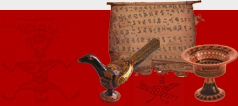| 您的位置:首页 --> 与会学者 --> 论文提要 |
凉山彝族绿色生存环境的依存情结及其归向之思考
Thoughts on the Causes and Consequences of Preserving a Green
Environment among the Liangshan Yi
陈阿依 Chen Ayi
凉山州奴隶社会博物馆
【摘要】凉山彝族居住的环境,决定了其与山林相依相伴的关系。依靠茂密的森林,凉山彝族创造了独具特色的民居建筑,轻便实用而色彩独特的各类木质漆具和享誉全球的火把节。彝族人有着优良的植树护林的传统,退耕还林、天保工程得到彝族人民的拥护和支持。然而,彝族人传统的生产生活方式,不稳定的居住习惯,以及盲目上马的基本建设项目等因素,对生态造成的负面影响也不可忽视。保护居住地长久延续是当下彝人必须考虑的首要问题,尤其是以森林为依托、以木材为基础来源的生活方式、生产习俗、各项宗教活动,以及节日、丧葬等本土文化的未来将何去何从,也同样耐人深思。
关键词: 彝族 生存环境
Abstract
The living environment plays a crucial role in the close relation
between Liangshan Yi minority and mountain forest. Depending upon
dense woods, Nuosu people create a unique cultural tradition distinguished
in folk architecture with wooden structure, all kinds of colorful
lacquered ware, as well as the well-known Fire Festival. Since
the Yi people have maintained their own traditional ways for tree
planting and tree protecting, the governmental projects such as
“tian bao gong cheng” and “tui geng huan lin gong cheng” won support
from local Yi people successfully. However, we cannot ignore the
facts that the traditional ways of production and life-making,
the unstable inhabitancy of local people, as well as the infrastructure
projects being aroused to precipitate action, all have produced
a greatly harmful impact on the ecologic environment. The author
suggests how to protect the residential areas is an overwhelming
challenge to the Yi minority in Liangshan as a whole. In particular,
everyone should take a reflective rethinking of traditional ways
largely depending on woods or lumbers, such as life style, productive
custom, various ritual activities, festivals, rites of passage,
and so forth. All the maters concerned afford for thought
Keywords: Yi people─living environment
作者简介:
陈阿依,1965年出生,1987年毕业于西南师范大学历史系,现就职于凉山奴隶社会博物馆。论文有《从昭觉县古墓葬和古遗址谈“卑水”》(《四川文物》1999年第4期),《凉山彝族的火文化》(《民族》2003年第12期)等。
About the Author:
Chen Ayi, born in 1965, graduated from the History Department
of the Southwest Normal University in 1987. She has been working
as an assistant curator in Liangshan Slavery History Museum since
1987. She has published a couple of papers, such as “Talking about
Beishui from the Old Graves and Relic Sites in Zhaojue County,”
Sichuan Cultural Relics, 1999(4); “ On Fire Culture of Laingshan
Yi People,” Minzu, 2003 (12) and so on.
|





